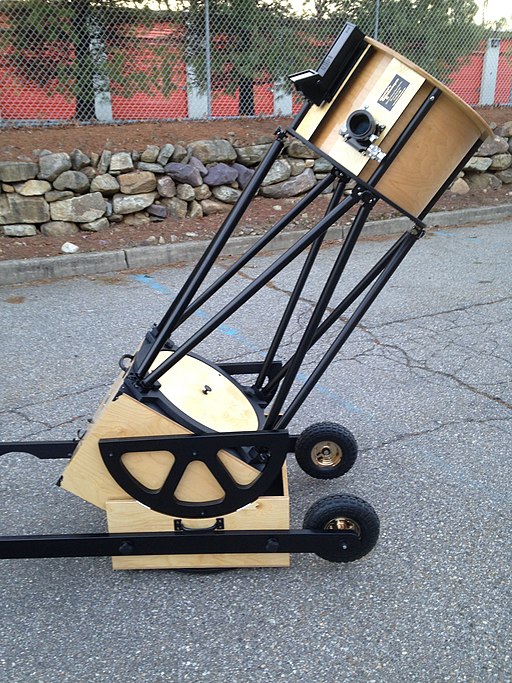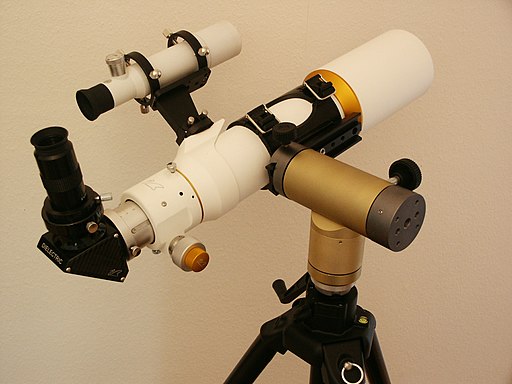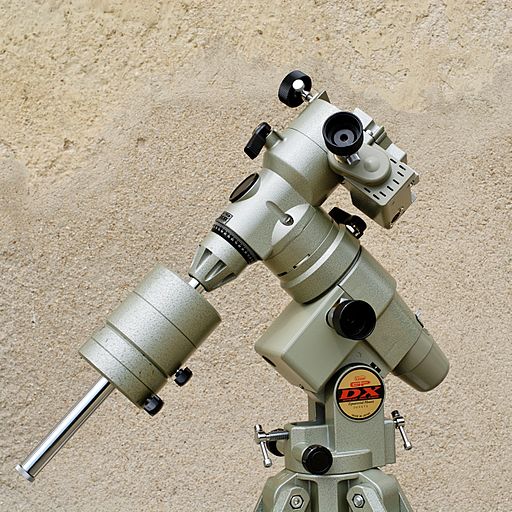Next to the OTA you choose, the mount it probably the second most important consideration. The mount does more then just hold your telescope up to a viewing level. The mount helps you find celestial objects easily, can hold a steady view even in a breeze,. It may be able to track stars countering the rotation of the Earth, and some can even find objects for you. For astrophotography, a high quality EQ mount is considered more important than any other component because of its ability to track moving objects smoothly and precisely while the camera is taking long exposure images. In many cases, if its your first telescope, you are probably buying a kit and you’ll get a mount. Understanding the types of mounts can help you find the right kit and help you manage your budget.
Box or Rocker (aka, Dobsonian)

A Dobsonian or rocker box mount is a simple mount for a reflector telescope. It’s essentially a cradle that holds the OTA in position. The OTA is balanced so that it can be moved up and down in altitude and will hold its position. The base of the mount is on a spindle which can be turned 360 degrees in azimuth. The mount can be built from any solid material with plywood and particle board covered in laminate being common. The altitude and azimuth axis usually have some soft of friction brake to make movements smooth and ensure the scope doesn’t easily drift away from where you want. Dobsonian mounts may be motorized though they often aren’t. You are the motor, hence the name, “push-to.” These mounts may have analog setting circles such as a compass and inclinometer which helps in pointing the scope at an object in the sky or maybe outfitted with digital setting circles which use digital encoders and a small computer to find objects. Dobsonian mounts are easy to build and customize–making them a favorite of DIY astronomers–and are well suited to carry a heavier OTAs like a large reflector. You won’t see Dobsonian mounts used for refractor or catadioptric telescopes.
Mounts like these suffer from out of balance OTA’s that can cause them to sag especially when pointing a objects closer to the horizon. The friction or spring bearings meant to stop the mount from moving can become worn over time. The OTA, since it is sitting in a cradle, can have backlash which is what happens when the OTA is pointed at an object and when you let it go, it dips, usually in the down direction. Backlash is often due to sloppy manufacturing and can be fixed with shims.
Alt-Az

Altitude-Azimuth, or Alt-AZ mounts describe a mount that moves in both directions independently. Alt-Az mounts have two axes, in the altitude (up and down) and azimuth (side-to-side). They come in a number of different configurations from one arm mounts to yoke or horsehoe mounts for larger OTAs. Alt-Az mounts are suitable for motorizing and computerized object finding but aren’t suitable for astrophotography because they track objects by first moving on one axis, then the other. The motion is like a stair step. For visual astronomy, that’s fine but for astrophotography the stair-step motion will blur the image. In addition, images produced from Alt-Az mounts suffer from field rotation which can be processed in software at the risk of losing image quality.
Alt-Az mounts are considerably less expensive than the equatorial style mounts and work extremely well for visual observers. Some motorized Alt-Az mounts may have knobs for manually driving the mount should you desire it or you don’t have electricity. An Alt-Az mount can be turned into an equatorial mount, described next, using an equatorial wedge.
Equatorial

An equatorial (EQ) mount is a mount where the Right Ascension (RA), or Azimuth axis, is aligned with the Earth’s axis. In the northern hemisphere, we align the mount to the North Celestial Pole (NCP) and in the southern hemisphere, the South Celestial Pole (SCP). Right Ascension marks locations on the celestial equator in terms of hours, minutes, and seconds similar to how latitude marks locations on Earth. Declination (Dec) marks locations on lines running between NCP, SCP and the Celestial Equator similar to how longitude marks locations on Earth.
Since the RA axis is parallel to Earth’s axis and aligned to the respective hemisphere’s celestial pole, if we point the telescope at a celestial object (not an object in our Solar System!), the mount can track the object in its arc across the sky just by turning the RA axis. The RA axis still points to the NCP, the mount is simply turning along a parallel plane. Equatorial mounts are used in astrophotography and for smoother object tracking for visual astronomers because the mount only turns on one axis to track celestial objects. There are many types of EQ mounts like a German Equatorial Mount (GEM) pictured left, or center balanced EQ mount.
Equatorial mounts more more expensive than Alt-Az mounts because of the machinery involved in making one. Portable EQ mounts are also more difficult to set-up because they have to be leveled and aligned to the celestial pole before every session. There are aides like alignment scopes that help in aligning to the celestial pole and computerized and motorized mounts will perform 1, 2, or 3 star alignments to help the computer to exactly determine its orientation. Once you get used to doing alignments a few times, it’s neither difficult nor time consuming but there is a learning curve and a time commitment before viewing. Luckily, you’re waiting for your OTA to get to ambient temperature anyway. Equatorial mounts don’t have field rotation like Alt-Az mounts have.
Bio
Mike Fratto is an amateur astronomer who can be found in his backyard or at Darling Hill Observatory on the rare nights its clear in Central New York.
